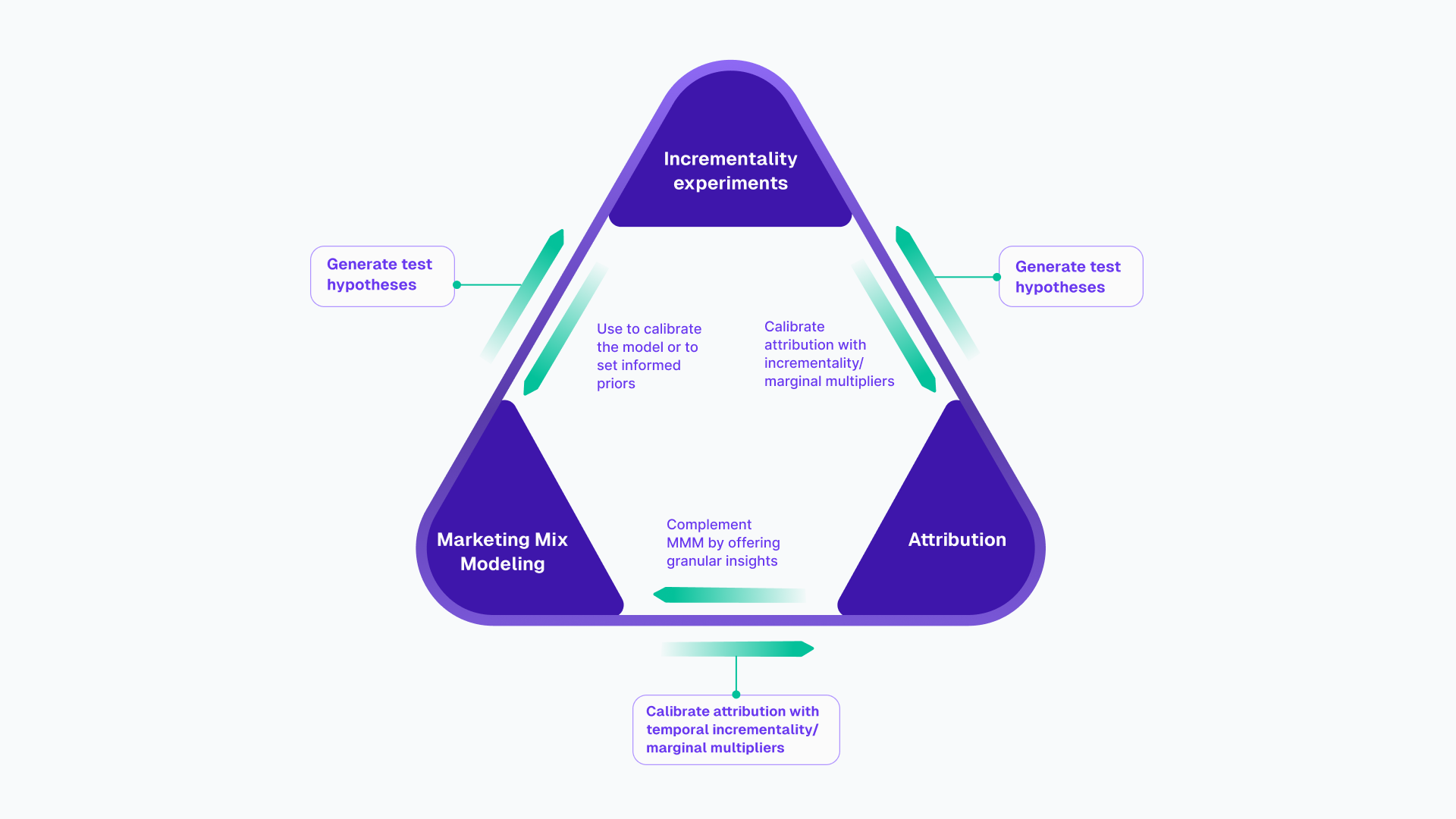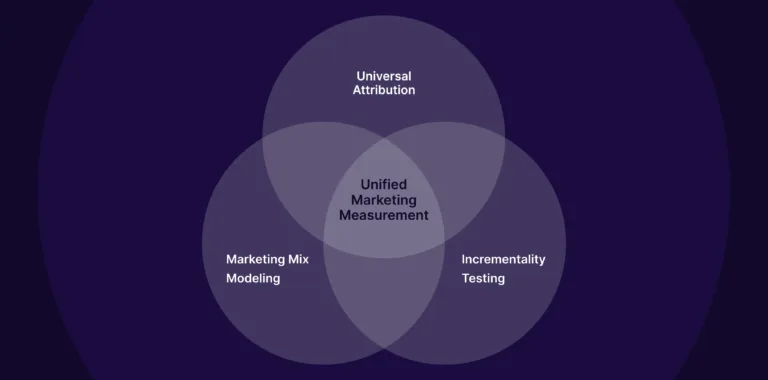The marketing landscape is undergoing rapid transformation. Privacy-first technologies, stricter regulations, and increasing signal loss, traditional attribution models are rapidly losing relevance. Compounding this, the complexity of today’s digital ecosystem and the lack of transparency across platforms have made it harder for marketers to measure true performance.
Despite these shifts, 41% of marketers still use last-touch attribution, 44% rely on first-touch attribution, according to ProperExpression. OWOX BI also found that 21% of marketers depended solely on single-channel attribution models in 2023 to 2024. These numbers highlight a continued reliance on outdated methods that fail to capture the full scope of the customer journey.
To overcome these limitations and make informed, strategic decisions, marketers must adopt a Unified Marketing Measurement (UMM) approach that integrates methodologies like Marketing Mix Modeling, Incrementality Testing, and Causal Attribution to deliver a unified, data-driven view of marketing performance across all channels.
What is Unified Marketing Measurement (UMM)?
Unified Marketing Measurement (UMM) is an advanced unified marketing analytics approach that combines historical and real-time data from both paid and organic marketing campaigns across online and offline channels. It uses triangulated marketing methodologies like Marketing Mix Modeling (MMM), Causal Attribution, and Incrementality Testing to deliver a unified data view of marketing campaign performance.
This unified data view helps marketers measure, analyze, forecast, and optimize marketing activities across channels, ultimately leading to smarter budget allocation and improved ROAS.
Watch this video to learn about Unified Marketing Measurement, presented by our Cofounder and Chief Product Officer, Rajeev.
Who Will Benefit from Using Unified Marketing Measurement (UMM) Methodology?
By Roles
- Chief Marketing Officers (CMOs)
- CFOs and Finance Teams
- Performance Marketers
- Marketing Teams Spending $20M+ Annually on Ads
- Marketing Consultants
By Industries
- eCommerce Businesses
- Retail Businesses (Omnichannel)
- Mobile App-Centric Businesses
- Consumer Services Companies
Other Beneficiaries
- Large enterprises running multi-channel campaigns
- Businesses focused on both brand and performance marketing
- Organizations navigating privacy regulations and data loss
What Pain Points Does Unified Marketing Measurement (UMM) Solve?
1. Fragmented Data Across Channels
The traditional marketing approach relies on independent strategies for each channel, such as digital, offline, and paid media, where performance is also measured and managed separately.
This leads marketers to:
- Struggle to get a unified, end-to-end view of overall marketing effectiveness
- Fail to identify true channel contribution and interaction effects
- Make suboptimal cross-channel budget allocation decisions
- Develop disconnected strategies due to inconsistent insights
How UMM Solves Fragmented Data Across Channels?
Unified Marketing Measurement (UMM) solves this challenge by integrating data from all marketing channels, including digital, offline, paid, owned, and earned, into a single, privacy-compliant framework.
A platform like Lifesight’s Unified Marketing Measurement solution simplifies this process and helps marketers make smarter, faster decisions across channels.
Explore how Lifesight can unify your fragmented data sources [Book a Demo]
This allows marketers to:
- Gain a unified, end-to-end view of overall marketing effectiveness
- Identify the true contribution and interaction of each channel
- Optimize cross-channel budget allocation using unified performance insights
- Drive unified strategy development based on consistent, integrated data
2. Inefficient Budget Allocation
When data insights are not unified or clear about which channels or campaigns truly drive business results, budgets often get misallocated, leading to wasted spend.
This leads marketers to:
- Overinvest in underperforming channels or campaigns
- Underfund high-potential channels or campaigns
- Struggle to justify spend and ROI to stakeholders
How UMM Solves Inefficient Budget Allocation?
UMM accurately attributes the impact and incrementality of each channel and campaign, helping marketers allocate or reallocate budgets with confidence.
With a platform like Lifesight, you can visualize the impact of your spend and easily reallocate budgets to the campaigns that deliver the highest returns.
This allows marketers to:
- Identify high-return marketing activities in specific campaigns and channels
- Redirect spend to the most effective channels
- Maximize ROAS by aligning budgets with unified marketing performance insights
3. Conflicting Attribution Models
Conflicting attribution models arise when different marketing platforms and measurement methods assign credit to customer touchpoints in varying ways.
For example, one model might give full credit to the last interaction before a conversion (last-click), another to the first interaction (first-click), and yet another distributes credit across multiple touchpoints (multi-touch attribution). These differing approaches can cause inconsistencies in understanding which channels or campaigns truly drive results.
This leads marketers to:
- Receive conflicting reports on campaign performance based on the attribution model used
- Struggle to compare performance across different channels
- Face difficulty in making informed budget allocation decisions
- Undervalue or overvalue certain channels due to inconsistent data
- Experience confusion and inefficiencies in overall strategy
How UMM Solves Conflicting Attribution Models?
UMM integrates the strengths of various attribution methods, such as MMM (Marketing Mix Modeling), Causal (Causal Attribution), and Incrementality Testing, into a single unified framework. Instead of relying on one model, it triangulates insights across multiple methodologies to provide a balanced and comprehensive view.
Lifesight’s causal attribution platform streamlines conflicting attribution results by combining data from Marketing Mix Modeling, incrementality testing, and causal modeling, all within one integrated solution.
This leads marketers to:
- Align insights across different models and teams
- Reduce contradictions in performance reporting
- Measure both short-term and long-term impact accurately
- Build confidence in marketing data and decision-making
- Enable more strategic and consistent budget allocation
4. Limited Understanding of Incrementality
Marketers struggle to accurately identify how much of their sales or conversions are truly caused by their marketing efforts versus what would have happened naturally without those efforts.
This leads marketers to:
- Overestimate the effectiveness of some campaigns or channels
- Misallocate budgets to tactics that don’t actually drive incremental results
- Fail to optimize marketing spend based on real business impact
How UMM Solves Limited Incrementality Insight?
Unified Marketing Measurement (UMM) incorporates incrementality testing methods such as geo experiments, holdout groups, and synthetic controls within its framework. This approach helps isolate the true impact or “lift” that specific marketing activities have on business outcomes by separating conversions driven by marketing from those that would have happened anyway.
Lifesight’s Incrementality Testing offers scalable geo experiments and automated control group setups. No data science team is required.
Want to know which campaigns are truly moving the needle? Try Lifesight’s plug-and-play incrementality tools.
This leads marketers to:
- Accurately measure the real incremental value of each channel and campaign
- Avoid overcrediting conversions that are not caused by marketing efforts
- Make better-informed budget allocation and optimization decisions based on actual business impact
5. Inability to Measure Offline Impact
Offline channels like TV, radio, and out-of-home (OOH) are often excluded or underrepresented in digital-first measurement tools.
This leads marketers to:
- Lack visibility into key upper-funnel activities
- Undervalue traditional media in mixed strategies
- Make incomplete budget allocation decisions
How UMM Solves Offline Measurement Gaps?
UMM incorporates offline media data into the same framework as digital, enabling a unified view across all touchpoints.
This allows marketers to:
- Measure the impact of offline campaigns
- Compare offline and digital performance fairly
- Make more holistic media planning decisions
The Core Marketing Models of Unified Marketing Measurement (UMM)
The core marketing models of unified marketing measurements are Marketing Mix Modeling (MMM), Causal Attribution and Incrementality testing.
1. Marketing Mix Modeling (MMM)
Marketing Mix Modeling (MMM) is a statistical technique that analyzes historical marketing campaign data such as clicks, impressions, marketing spend, pricing, product features, and external factors like seasonality and trends to measure the impact of various marketing activities on sales or other key business performance indicators (KPIs).
Read More About: Best Marketing Mix Modeling Softwares in 2025
2. Incrementality Testing
Incrementality testing is a marketing experimentation method that includes geo testing and holdout testing to measure the true causal impact of a campaign by comparing outcomes between two groups, a test group exposed to the marketing activity and a control group that is not, and isolates the additional sales or conversions directly caused by the campaign, helping marketers understand whether their efforts are genuinely driving incremental results beyond natural demand or other external factors.
3. Causal Attribution
Causal Attribution is a statistical causal inference methodology that determines the true incremental impact of individual marketing touchpoints on customer behavior. Unlike correlation-based methods such as last-touch, first-touch, and multi-touch attribution, causal attribution often relies on incrementality testing data, including geo-lift studies, to accurately measure how much a campaign lifts sales or conversions.
Triangulation in Unified Marketing Measurement (UMM)
In unified marketing measurement, triangulation refers to the practice of integrating Marketing Mix Modeling (MMM), incrementality testing, and causal attribution with each other to get closer to the “truth” of marketing effectiveness.
This allows the decision-makers (CMOs, CFOs, etc) to not only measure but also predict how their marketing strategies will impact their main business goals with UMM.
The below image illustrates how we approach triangulation in marketing

How does Unified Marketing Measurement (UMM) Work? A Step-by-Step Guide
STEP 1: Data Collection and Integration
Unified Marketing Measurement (UMM) begins by collecting and integrating data from all marketing channels, both online and offline, as well as from business systems. This includes impressions, clicks, spend, conversions, CRM records, sales data, product pricing, promotions, and external factors such as seasonality or economic trends.
STEP 2: Define Key Business Metrics
Once the data is unified, the next step is to define the primary KPIs the business aims to optimize. These may include CPA, CPM, CPC, revenue, conversions, or return on ad spend (ROAS). Establishing these KPIs ensures team alignment and focuses modeling efforts on what matters most. All components of UMM, including MMM, causal attribution, and incrementality testing, work toward optimizing these business outcomes.
STEP 3: Apply Marketing Mix Modeling (MMM)
With KPIs in place, MMM analyzes historical data to estimate the contribution of each marketing channel and external factors, such as pricing or seasonality, to overall performance. It captures long-term trends and is especially effective for offline and aggregate-level insights.
STEP 4: Move Beyond Multi-Touch Attribution (MTA)
Traditional Multi-Touch Attribution (MTA) relies on user-level tracking and correlation-based credit assignment. However, MTA has become less reliable due to increasing privacy regulations and tracking limitations. It often struggles to isolate true causality, which can lead to inaccurate attribution.
STEP 5: Implement Causal Attribution
To address the limitations of MTA, UMM uses Causal Attribution. This statistical causal inference methodology measures the true incremental impact of each marketing touchpoint. It incorporates techniques such as uplift modeling, counterfactual analysis, geo-lift studies, and synthetic controls to determine which interactions actually influenced conversions.
STEP 6: Conduct Incrementality Testing
Controlled experiments, including geo-lift tests, holdout testing, and synthetic control groups, are conducted to validate and quantify the additional impact driven by marketing. These tests help isolate true lift from baseline activity.
STEP 7: Integrate Results and Optimize Strategy
UMM combines insights from MMM, causal attribution, and incrementality testing to deliver a unified and comprehensive view of marketing effectiveness. With this data, marketers can reallocate budgets more accurately and optimize both short-term and long-term impact.
STEP 8: Continuous Monitoring and Model Refinement
UMM is an ongoing process. Models are continuously updated with new data to reflect changes in consumer behavior and market dynamics, ensuring the insights remain accurate and actionable.
What is the Required Data to Accurate Unified Marketing Measurement (UMM)?
1. Marketing Spend Data
Detailed spend information across all channels, along with timestamps and campaign details.
The channels include:
- Digital
- TV
- Radio
- OOH (Out Of Home).
2. Impression and Engagement Data
- Ad impressions
- Clicks
- Video views
- Engagement metrics
3. Sales and Conversion Data
- Online and offline sales
- Leads
- Conversions
- Other key business outcomes are tied to marketing efforts.
4. Customer and Audience Data
- Demographics
- Behavioral data
- CRM information
- Customer journey insights
5. Media Delivery and Exposure Data
Data on when and where ads were delivered or seen, including frequency and reach metrics.
6. Experiment and Incrementality Test Results
- A/B test outcomes
- Holdout group data
- Lift test results to measure causal impact.
7. Offline Data Sources
- Store footfall,
- Point-of-Sale (POS) data
- Call center logs,
- Other offline touchpoints.
8. Macro and Environmental Data
External factors like
- Seasonality
- Economic indicators
- Competitor activity
- Market trends.
9. Attribution and Tracking Data
- Clickstream data,
- Device IDs,
- Cookie data (where privacy compliant)
- Other tracking signals.
10. Privacy-Compliance and Consent Data
Information ensuring data usage complies with GDPR, CCPA, and other privacy regulations.
Best Unified Marketing Measurement Tool
Lifesight stands out as the best Unified Marketing Measurement tool by seamlessly integrating multiple data sources and marketing models such as Marketing Mix Modeling (MMM), Causal Attribution, and Incrementality Testing into a unified framework. It empowers marketers with a unified view of their marketing performance across both digital and offline channels, enabling data-driven decisions that optimize budget allocation and maximize ROAS.
Get Started with Lifesight’s Unified Marketing Measurement Platform to Maximize Your ROAS
How Lifesight helps you Get Started with Unified Marketing Measurement (UMM)?
Lifesight makes Unified Marketing Measurement straightforward and effective. They work closely with you to bring together all your marketing data, from digital ads to offline channels, into one clear view. Lifesight sets up customized measurement models that fit your unique business needs while ensuring everything stays privacy compliant. With simple dashboards and ongoing support, they help your team understand what is really driving results so you can make smarter, faster marketing decisions for profitable growth.
No technical setup —> No guesswork —> Just results. “Book A Demo”
Conclusion
Unified Marketing Measurement (UMM) empowers modern marketers to connect the dots across all channels and touchpoints. By combining methodologies like Marketing Mix Modeling, Incrementality Testing, and Causal Attribution, UMM delivers a comprehensive, real-time view of marketing performance that drives smarter decisions, better budget allocation, and improved return on ad spend.
As marketing continues to evolve across digital and offline landscapes, UMM provides a clear, data backed foundation for achieving sustainable growth and measurable business impact.
Lifesight helps you automate this entire process, integrating data, running advanced analyses, and delivering actionable insights so your marketing measurement is seamless, efficient, and continuously optimized.
FAQ’s
1. What is Unified Marketing Analytics Measurement?
Unified Marketing Analytics Measurement is an integrated approach that combines multiple measurement methodologies, such as Marketing Mix Modeling (MMM), Causal Attribution, and Incrementality Testing, to provide a holistic view of marketing performance. It enables marketers to assess the combined impact of all channels and touchpoints, both online and offline.
2. What is Person level unified measurement?
Person-level Unified Measurement in marketing builds a comprehensive, unified view of individual customer journeys by consolidating data from various sources, including online and offline, paid and organic marketing channels. It tracks engagement and conversions at the individual level, enabling more precise attribution and campaign optimization.
3. What is Financial Unified Marketing Analytics Measurement?
Financial Unified Marketing Analytics Measurement links marketing performance to key financial outcomes like revenue, ROAS, and CAC, helping teams make smarter, budget-conscious decisions.
4. How is Unified Marketing Measurement different from traditional attribution models?
Unified Marketing Measurement is different from traditional attribution models, which typically assign credit only to the first or last touchpoint and focus solely on digital interactions. In contrast, Unified Marketing Measurement attributes value across all relevant touchpoints across channels and provides a unified view of marketing performance across both online and offline channels.
5. How does UMM combine Marketing Mix Modeling (MMM) and Causal Attribution (CA)?
Unified Marketing Measurement (UMM) combines Marketing Mix Modeling (MMM) and Causal Attribution. MMM analyzes aggregate data such as total sales, overall media spend, broad market trends, and more to measure the overall impact of marketing channels, including offline media, over time. Causal Attribution focuses on user-level data like individual website visits, ad exposures, clicks, conversions and more. By combining both methodologies, UMM uses experimental or observational methods to identify the true incremental effect of specific marketing touchpoints.
6. Is Unified Marketing Measurement suitable for both online and offline channels?
Yes, Unified Marketing Measurement is suitable for measuring both online and offline marketing campaign efforts using a single, unified measurement framework.
7. Can small to mid-sized U.S. businesses benefit from Unified Marketing Measurement?
Yes, businesses of any size in the U.S. that spend $20 million or more on both online and offline marketing campaigns can benefit from Unified Marketing Measurement.
8. How frequently should I update or recalibrate my UMM models?
Unified Marketing Measurement models automatically recalibrate whenever new data is collected from incrementality experiments, ongoing campaign performance, external sources, and more. This ensures the model stays accurate and up to date without manual intervention.
9. How long does it take to see actionable insights from UMM?
Lifesight Unified Marketing Measurement platforms typically provide actionable insights such as budget allocation recommendations immediately after analyzing unified data from multiple sources including online and offline campaign performance, incrementality test results, sales data, and external market trends.
10. Do I need a data science team to implement Unified Marketing Measurement?
Not with Lifesight. Our platform automates model building and provides intuitive dashboards, so your team can focus on decision-making instead of analytics.
11. How can UMM help in optimizing media budget allocation across channels?
Unified Marketing Measurement platforms integrate all aggregated marketing data to perform advanced marketing analysis to identify high- and low-performing campaigns and channels, and also by leveraging factors like incrementality testing, historical data, consumer behavior insights, and market trends, UMM helps optimize budget allocation across both online and offline channels for maximum impact.
12. What industries in the U.S. have seen the most success with Unified Marketing Measurement?
Industries in the U.S. that have seen the most success with Unified Marketing Measurement include retail, e-commerce, consumer packaged goods (CPG), automotive, telecommunications, and financial services. These sectors typically run large-scale, multi-channel marketing campaigns and benefit greatly from UMM’s ability to measure both online and offline performance and optimize media spend accordingly.
13. Can UMM integrate with my existing marketing tech stack (e.g., Google Analytics, CRM, CDP)?
Yes. Lifesight connects with Google Analytics, CRM systems, CDPs, and major ad platforms. Integration is seamless and designed to support your existing workflow.
14. How does UMM support incrementality testing and causal analysis?
Unified Marketing Measurement supports incrementality testing and causal analysis by integrating experimental and observational data to measure the true impact of marketing efforts. It uses techniques like geo-based tests, holdout groups, and A/B testing to isolate the effect of specific campaigns or channels. This helps marketers understand what truly drives incremental results, rather than just correlations, leading to more accurate optimization and smarter budget decisions.
15. What KPIs can be improved by adopting a UMM framework?
Adopting a Unified Marketing Measurement (UMM) framework can improve key performance indicators (KPIs) such as return on ad spend (ROAS), customer acquisition cost (CAC), marketing efficiency ratio (MER), incremental sales, conversion rates, and overall campaign ROI.
16. What is the ROI of implementing Unified Marketing Measurement?
Many businesses see a 15 to 20% increase in the impact of their marketing spends through better budget allocation and optimized campaign performance, resulting in a significantly higher overall ROI.
You may also like
Essential resources for your success






















































